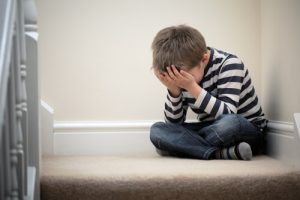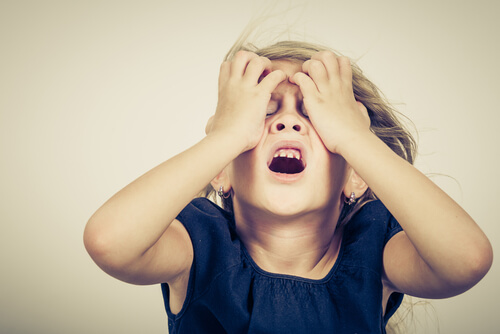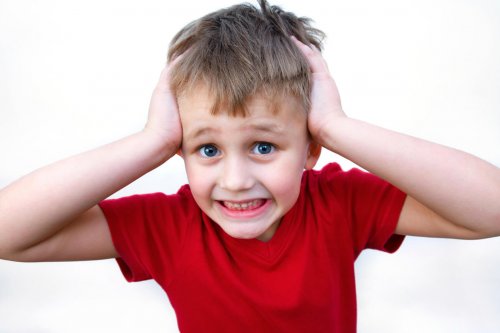Are you producing anxiety in your child without knowing it?

What are the causes behind anxiety in children?
Children are generally positive and in a good mood. They are always full of energy and in search of new adventures.
However, when a child’s behavior starts to show long-lasting change, with no apparent cause, then it’s time to take action. It’s important to take time and analyze who or what is behind this change.
The first step is for parents to do some introspection and ask: Are my attitudes and actions causing my child to become anxious?
You should also take a look at other friends and family members who have constant contact with your little one.
Sometimes parents can unknowingly encourage insecurities in their children. These same insecurities produce feelings of stress and anxiety.
While this is not your intention, you may be producing anxiety in your children through excessively authoritative attitudes. The opposite extreme – excessive permissiveness – can also cause a child to suffer from anxiety.
Here are examples of specific attitudes that are capable of producing anxiety in children:
- Overprotective parenting
- Denying your child the right to develop his or her own personality
- Not allowing your child to make his or her own decisions
- Constant criticism
Signs and symptoms of anxiety in children
Children who suffer from anxiety and stress develop very clear symptoms that any parent can identify. However, it’s important for parents to be informed about the symptoms in order to recognize them. Parents must also be attentive to any change in behavior that their child displays.
The symptoms of stress and anxiety tend to appear simultaneously in two well-defined areas of the child’s life. The first is emotional, and the second, physical. In general, these two realms go hand in hand. Symptoms may be isolated, or you may observe several at once.

Emotional symptoms
Without a doubt, one of the most evident emotional symptoms of anxiety is lack of empathy. Another equally predominant symptom is apathy.
This apathy may be directed towards school and studies, or even toys, friends, and other activities your child once enjoyed.
Other signs include sadness, lack of appetite, irritability, aggressive behavior, fear, insecurity, inability to concentrate.
Negative thoughts are also often constantly present in children who suffer from anxiety.
“When a child’s behavior starts to show long-lasting change, with no apparent cause, then it’s time to take action”
Physical symptoms
When stress and anxiety reach high levels, then physical symptoms appear as well. These symptoms can be so strong that they are often confused with other illnesses. Therefore, it’s important to pay attention to the emotional symptoms as well.
Anxiety can bring on a wide range of physical symptoms. Your child can display everything from excessive perspiration or tachycardia to strong headaches or abdominal pain.
Other physical manifestations can include stuttering, bed-wetting, muscle pain, trembling, fainting, immobility, frequent colds and excessive crying.
How to deal with anxiety in children
The best way to face the anxiety your child is suffering is to identify and deal with the cause. Therefore, introspection is the first step.
The second step is to evaluate whether your child’s anxiety is something recent, or if your child has been suffering for some time already. You may want to consult with a specialist who can help your child deal with these negative feelings.
Maintaining constant, open, and respectful communication is key to building up your child’s confidence. At the same time, parents can create small changes that help their children reduce their stress levels.

It’s very important that you avoid being overprotective of your children. Also, be careful of the things you say so as not to criticize or correct them constantly.
Give your children the freedom to make some of their own decisions, rather than deciding everything for them. This will help to safeguard your child’s mental and emotional development.
If your child’s anxiety levels don’t go down despite heeding the suggestions above, then you must seek professional assistance. A specialist may recommend psychological assistance, medication, and/or family counselling.
“The best way to face the anxiety your child is suffering is to find out and deal with the cause. Therefore, introspection is the first step.”
Are you producing anxiety in your child? Fortunately, this is a problem that can be solved through simple measures.
The most important step is recognizing the symptoms and behavioral changes in your child in order to help him or her overcome this emotional state. With a bit of patience and lots of love, your child will once again be happy, enthusiastic and full of energy.
All cited sources were thoroughly reviewed by our team to ensure their quality, reliability, currency, and validity. The bibliography of this article was considered reliable and of academic or scientific accuracy.
- Bragado, C., Bersabé, R., & Carrasco, I. (1999). Factores de riesgo para los trastornos conductuales, de ansiedad, depresivos y de eliminación en niños y adolescentes. Psicothema, 11(4). https://www.redalyc.org/html/727/72711415/
- Cárdenas, E. M., Feria, M., Palacios, L., & de la Peña, F. (2010). Guía clínica para los trastornos de ansiedad en niños y adolescentes. México: Instituto Nacional de Psiquiatria Ramón de la Fuente Muñiz.
- Fernandez, L. E. (2009). Ansiedad infantil e implicación de los padres: una revisión. Behavioral Psychology/Psicologia Conductual, 17(1), 67-88. https://go.galegroup.com/ps/anonymous?id=GALE%7CA226571530&sid=googleScholar&v=2.1&it=r&linkaccess=abs&issn=11329483&p=AONE&sw=w
- Reynolds, C. R., & Richmond, B. O. (1997). Escala de ansiedad manifiesta en niños (revisada). El Manual Moderno.
This text is provided for informational purposes only and does not replace consultation with a professional. If in doubt, consult your specialist.








